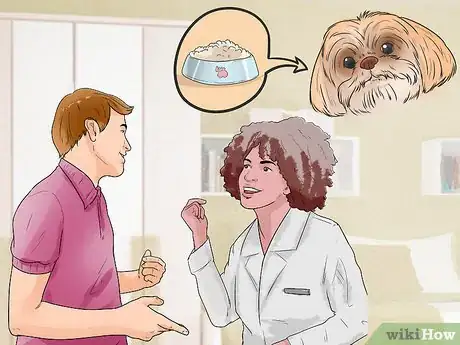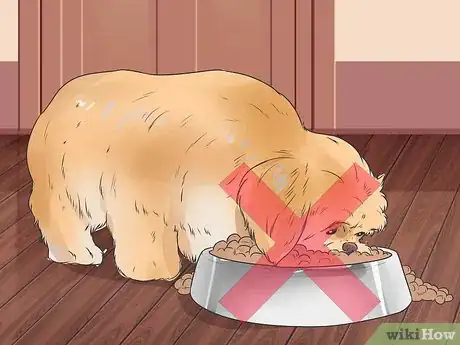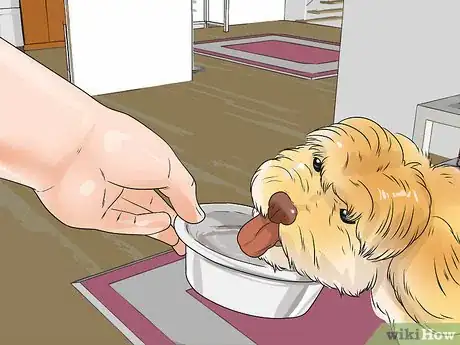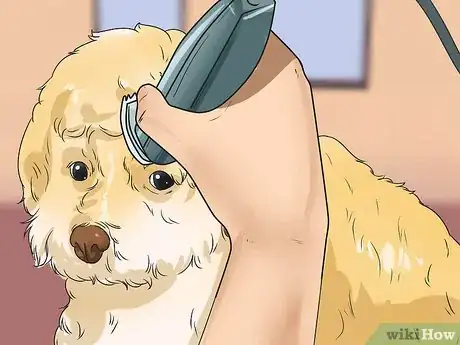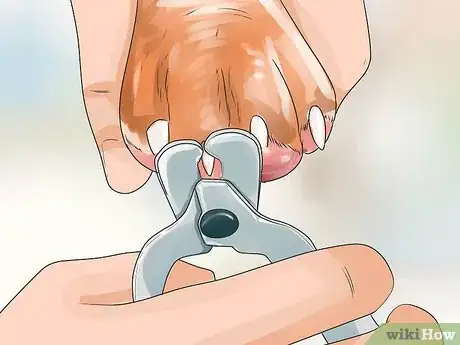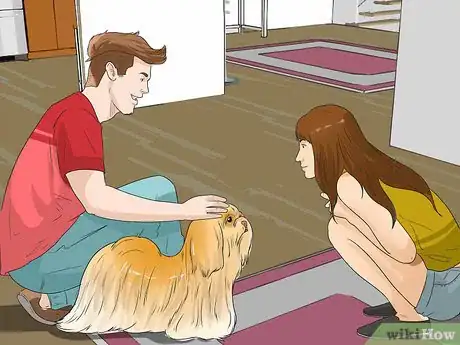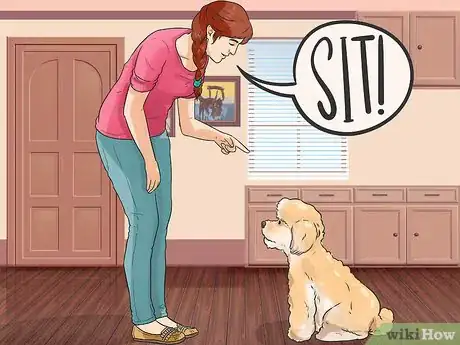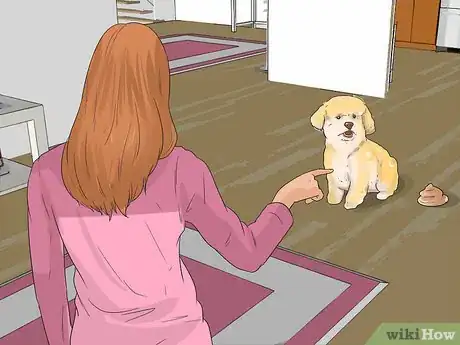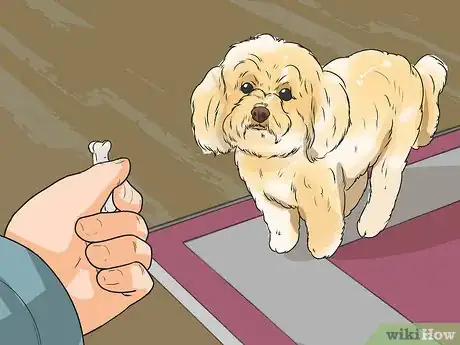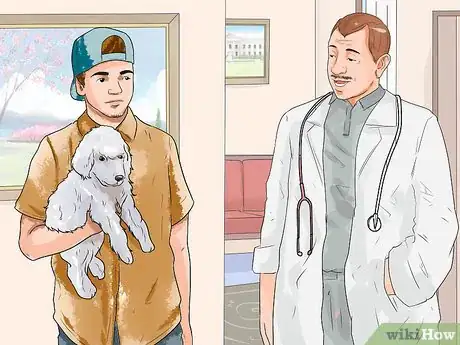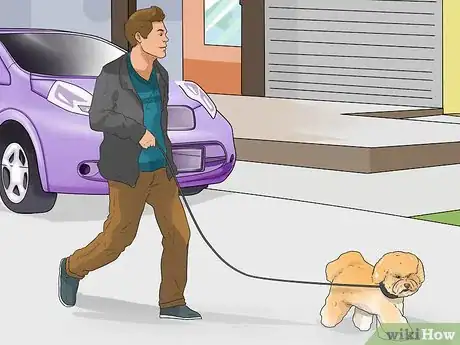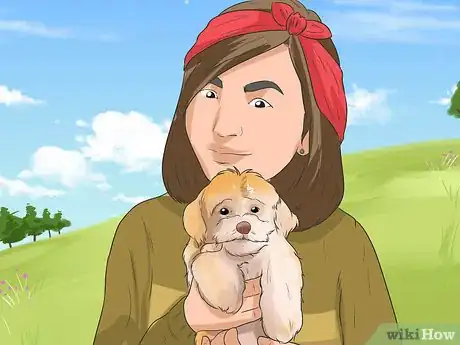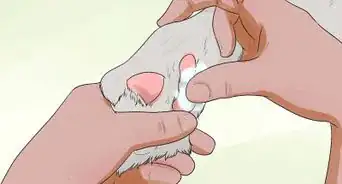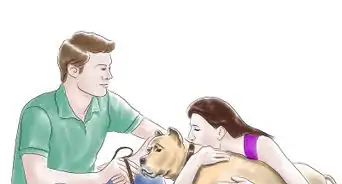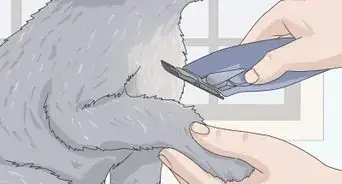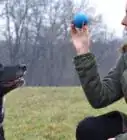This article was co-authored by Colleen Demling-Riley, CPDT-KA, CBCC-KA, CDBC. Colleen Demling-Riley (CPDT-KA, CBCC-KA, CDBC) is a Canine Behavior Consultant and the Founder of Pawtopia Dog Training. With more than 20 years of experience, she specializes in creating and customizing dog management programs for dog owners. She is a Certified Pet Dog Trainer-Knowledge Assessed, Certified Behavior Consultant Canine-Knowledge Assessed, Certified Dog Behavior Consultant, and American Kennel Club Canine Good Citizen Evaluator. Colleen is a member of the International Association of Canine Professionals and has been a featured expert in national media including the New York Times, Woman’s Day, Readers Digest, Cosmopolitan, and Yahoo.com.
wikiHow marks an article as reader-approved once it receives enough positive feedback. In this case, 92% of readers who voted found the article helpful, earning it our reader-approved status.
This article has been viewed 147,629 times.
Getting a new dog, especially a dog as wonderful as a Lhasa apso, can be tremendously exciting. Whether you are getting an energetic puppy or a wonderful older dog, your life will be enhanced by having it around. However, you will need to figure a lot of things out in order raise a dog that is healthy and happy. Take the time to figure out how to take care of your dog, so that it can more easily become an important and loved part of your family. As a dog owner, you will need to feed, groom, train, and take care of the health of your dog, at the very least.
Things You Should Know
- Feed your dog 1-2 times a day. Their meal should be mainly protein, and it shouldn't include much grain.
- Lhasa apso can have a hard time meeting strangers, so prioritize their training. Socialize them early with other people and dogs.
- Keep up with your pup's health needs. Take them on walks regularly and keep them up to date on shots and vaccines.
Steps
Feeding
-
1Feed your dog quality food. Lhasa apsos, like other dogs, usually eat 1-2 times a day, depending on how you want to space out their meals. Choose a dog food that is low in grains and high in protein, as a dog is naturally carnivorous.
- Follow the suggestions on the food packaging when determining how much food to feed your Lhasa. This suggestion is usually based on the dog's weight and how old they are.
- Consult with your veterinarian if you have questions about your dog's diet. They should have good suggestions about appropriate amounts to feed your dog and what brands might fit your dog's particular dietary needs best.
- A high-quality diet is an important factor of your dog living a long and healthy life.
-
2Don't overfeed your pet. It can be hard to resist a cute Lhasa face when it is begging for a little treat. However, for the health of the dog, resist giving it too many calories.
- If you do want to give your dog treats, reserve the treats for training sessions. That way your dog will get the satisfaction of a treat and a new skill at the same time.
- Giving your dog a small reward or "bonus" increases their desire to learn and listen.
Advertisement -
3Give access to water at all times.[1] No matter what type of dog you have, you should make sure that it always has access to water. Dehydration can occur quickly and it is inhumane to put a dog through that due to negligence.
Grooming
-
1Brush your dog. Try using a double sided brush, one with separated pins on one side and the other with nice smooth bristles. This will give you several options for different areas of the coat. Also, remember to brush with the direction of hair growth, so that you don't tangle the coat further.
- Remember to brush your Lhasa at least weekly or its coat can get terribly tangled.
-
2Get your Lhasa's coat cut. Lhasa apsos are naturally long haired, but can have short hair, often called a "puppy cut."[2] Either way, they will need to get a cut on a regular basis, unlike short-haired dogs whose fur falls out. Decide which cut you like best and take your Lhasa to a groomer to get the cut.
- If you like a challenge, you can groom your dog yourself. However, this takes quite a bit of skill so you may want to do some research and have some practice before you decide to do a full grooming yourself.
- A "puppy cut" is easier to care for and cooler for the dog. Consider getting your dog a "puppy cut" if you are having a hard time keeping up with brushing or your dog is getting overheated.
-
3Trim your dog's nails and check its ears. These things do not need to be done as often as brushing your dog's coat, but they should be done on a regular basis.[3] Taking the time to assess your dog's feet and ears is a good way to bond with the dog and keep track of its general physical health.
- Trim your Lhasa's nails down but do not cut the quick of the nail, where the nail is alive, or this will be painful for the dog and it may bleed.
- Begin cleaning your dog's ears by looking in them for dirt and debris. If you see it, clean it out with a dry, soft cloth. Also look for infections or mites, which should be treated by a veterinarian.
-
4Brush your Lhasa's teeth regularly. Like other dogs, a Lhasa apso's teeth should be brushed with dog toothpaste on a regular basis to avoid tooth decay. In fact, brushing your dog's teeth can be a good training exercise and it will help freshen its breath as well.[4]
- To get your dog used to a tooth brushing, you need to introduce the process gradually. Start with some dog toothpaste and let the dog lick it off your finger. Then, the next day, try sticking the toothpaste on your finger in its mouth. Gradually work up to the toothpaste on a doggie toothbrush and putting it onto the dog's teeth.
- It can take some time to get a dog acclimated to tooth brushing. So, don't worry if your dog has a hard time with it. Just keep trying.
- Do not use toothpaste made for humans. It can be toxic for dogs. Instead, you should get toothpaste for dogs, which is available online or at your local pet store.
Training
-
1Socialize your dog early. Lhasa apsos can be suspicious of strangers, so it's good to get them used to a variety of people and places early in life. This includes other dogs. Socializing a Lhasa apso well can minimize that instinct.[5]
- Lhasa apsos that are not socialized very well can get very jealous with other dogs. Keep your dog away from other dogs until you are sure that it can interact with other dogs without getting aggressive.
-
2Train your Lhasa to follow basic commands. All dogs should be trained to sit, stay, come, lay down, and heel. A well trained dog is a joy to have in your home and your bond with the dog will be stronger if you have a clear understanding about the expectations you have for your dog.
- This training can take some time but it is worth the effort.
-
3Train your dog to go to the bathroom outside. This is an important training process so that the dog knows where and when to go to the bathroom and so that it does not have accidents in the house. Potty training can take some time, especially with a stubborn dog like a Lhasa apso, so take your time and try to be patient.[6] With enough work and consistency, your dog will get the hang of it.
- Some pet owners use "pee pads" so that a dog can go to the bathroom inside. If you want to do this, you will still need to train the dog to go on the pad and not other places in your home.
-
4Be vigilant and consistent about training. Some Lhasa's are stubborn and difficult to train. However, if you are consistent and unwilling to give up, your dog will be more likely to learn to follow your commands.
- Lhasas often are not motivated to listen to humans or follow their directions. Because of this, make sure you have a small treat to use for training, as this will make the dog more likely to pay attention to you.
Medical Care
-
1Take the dog for regular veterinary checkups. This is very important in order to keep your Lhasa in tip top shape. Your veterinarian will make sure that the dog is up to date on its vaccinations and that its general health is fine.
- Lhasa apsos do not really suffer from many hereditary diseases, however they can have problems with their kidneys. Have your Lhasa screened for renal dysplasia so that you can start treatment before an issue becomes serious.
-
2Give your dog regular exercise. Even though a Lhasa apso does not require as much exercise as a working dog, for instance, that does not mean that it doesn't require any exercise. Walk and play with him or her often. In fact, Lhasa apsos enjoy daily walks and regular play times.[7]
- Make sure your dog is on a leash for walks. Lhasas can be very interested in strangers and new areas, so if off leash it may wonder off.
-
3Be affectionate to your dog. As a dog, the thing it needs most is love. This love can be shown by playing with your dog, going to the dog park, playing inside, or just snuggling on the couch. However you like to spend time with your dog, do it.
- Just be sure to give it enough attention so that it doesn't get depressed due to loneliness.
- However, Lhasa apso are usually ok if you leave them at home while you go to work. They do not usually get separation anxiety like some other breeds do.
Expert Q&A
-
QuestionHow do I keep my Lhasa Apso healthy?
 Colleen Demling-Riley, CPDT-KA, CBCC-KA, CDBCColleen Demling-Riley (CPDT-KA, CBCC-KA, CDBC) is a Canine Behavior Consultant and the Founder of Pawtopia Dog Training. With more than 20 years of experience, she specializes in creating and customizing dog management programs for dog owners. She is a Certified Pet Dog Trainer-Knowledge Assessed, Certified Behavior Consultant Canine-Knowledge Assessed, Certified Dog Behavior Consultant, and American Kennel Club Canine Good Citizen Evaluator. Colleen is a member of the International Association of Canine Professionals and has been a featured expert in national media including the New York Times, Woman’s Day, Readers Digest, Cosmopolitan, and Yahoo.com.
Colleen Demling-Riley, CPDT-KA, CBCC-KA, CDBCColleen Demling-Riley (CPDT-KA, CBCC-KA, CDBC) is a Canine Behavior Consultant and the Founder of Pawtopia Dog Training. With more than 20 years of experience, she specializes in creating and customizing dog management programs for dog owners. She is a Certified Pet Dog Trainer-Knowledge Assessed, Certified Behavior Consultant Canine-Knowledge Assessed, Certified Dog Behavior Consultant, and American Kennel Club Canine Good Citizen Evaluator. Colleen is a member of the International Association of Canine Professionals and has been a featured expert in national media including the New York Times, Woman’s Day, Readers Digest, Cosmopolitan, and Yahoo.com.
Canine Behavior Consultant Beyond the basic — exercise, vet checkups and quality diet — training is really important. Just like humans, dogs get more disengaged when older. But, if learning continues, especially with interactive toys and games, you can keep your dog engaged, which helps them be healthy and live longer.
Beyond the basic — exercise, vet checkups and quality diet — training is really important. Just like humans, dogs get more disengaged when older. But, if learning continues, especially with interactive toys and games, you can keep your dog engaged, which helps them be healthy and live longer. -
QuestionHow do I stop my dog from barking?
 Colleen Demling-Riley, CPDT-KA, CBCC-KA, CDBCColleen Demling-Riley (CPDT-KA, CBCC-KA, CDBC) is a Canine Behavior Consultant and the Founder of Pawtopia Dog Training. With more than 20 years of experience, she specializes in creating and customizing dog management programs for dog owners. She is a Certified Pet Dog Trainer-Knowledge Assessed, Certified Behavior Consultant Canine-Knowledge Assessed, Certified Dog Behavior Consultant, and American Kennel Club Canine Good Citizen Evaluator. Colleen is a member of the International Association of Canine Professionals and has been a featured expert in national media including the New York Times, Woman’s Day, Readers Digest, Cosmopolitan, and Yahoo.com.
Colleen Demling-Riley, CPDT-KA, CBCC-KA, CDBCColleen Demling-Riley (CPDT-KA, CBCC-KA, CDBC) is a Canine Behavior Consultant and the Founder of Pawtopia Dog Training. With more than 20 years of experience, she specializes in creating and customizing dog management programs for dog owners. She is a Certified Pet Dog Trainer-Knowledge Assessed, Certified Behavior Consultant Canine-Knowledge Assessed, Certified Dog Behavior Consultant, and American Kennel Club Canine Good Citizen Evaluator. Colleen is a member of the International Association of Canine Professionals and has been a featured expert in national media including the New York Times, Woman’s Day, Readers Digest, Cosmopolitan, and Yahoo.com.
Canine Behavior Consultant Use a command like "quiet", but say it calmly, and not yelling. Otherwise, the dog will think you're barking with it. If the dog complies, toss some treats on the floor as a reward. This will reinforce the behavior, especially because the dog can't bark when it's foraging for treats.
Use a command like "quiet", but say it calmly, and not yelling. Otherwise, the dog will think you're barking with it. If the dog complies, toss some treats on the floor as a reward. This will reinforce the behavior, especially because the dog can't bark when it's foraging for treats.
References
- ↑ http://www.akc.org/dog-breeds/lhasa-apso/care/
- ↑ http://www.akc.org/dog-breeds/lhasa-apso/care/
- ↑ http://www.akc.org/dog-breeds/lhasa-apso/care/
- ↑ http://www.akc.org/dog-breeds/lhasa-apso/care/
- ↑ http://www.akc.org/dog-breeds/lhasa-apso/care/
- ↑ http://www.lhasaapsorescue.org/housetraining.html
- ↑ http://www.akc.org/dog-breeds/lhasa-apso/care/
About This Article
To care for a Lhasa Apso, feed it a dog food that’s high in protein and low in grain twice a day. Additionally, take it for walks and play with it often so make sure it gets enough exercise. You should also brush your dog’s coat at least once a week with a double-sided brush to avoid tangles. Alternatively, consider bringing your Lhasa Apso to a groomer for a shorter “puppy cut,” which is easier to care for and cooler for your dog. For more tips from our Veterinary co-author, including how to socialize your Lhasa Apso puppy, keep reading.
